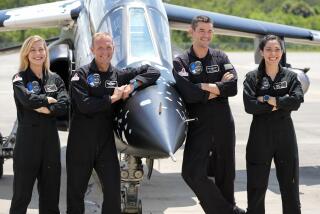Dreaming of Bus Shuttles, With Mars as Destination
- Share via
WEST LAFAYETTE, Ind. (AP) — WEST LAFAYETTE, Ind.--Though it will likely be decades before a human sets foot on the surface of Mars, former astronaut Buzz Aldrin and scientists at Purdue University already are working on a shuttle they hope will one day take people from Earth to the Red Planet and back.
The interstellar bus line would involve two massive spacecraft that could house up to 50 people on their six-month shuttles between the two planets. The craft would continuously cycle between Earth and Mars using gravity as their primary power source, with an occasional shot from a booster rocket.
“If we’re going to go to Mars with human beings, we need to do it in an evolutionary way, so that we can continue doing it,” said Aldrin, the second man to walk on the moon.
James Longuski, a professor of aeronautics and astronautics at Purdue, agrees that it doesn’t make sense to land the first people on Mars without knowing how to land more.
“We want to know what the transportation setup would look like before we’ve even set foot on Mars,” Longuski said.
While it may sound like putting the wagon a few light-years ahead of the horse, Jim Garvin, NASA’s lead scientist for Mars exploration, said these ideas must be considered now, even though human travel to Mars is a distant goal. In fact, it’s not on the current administration’s radar.
NASA’s Mars program has been set back in recent years, particularly in 1999 when two spacecraft failed upon reaching Mars, one burning up in the planet’s atmosphere and the other disappearing after a software failure.
The program got back on track earlier this year when the Mars Odyssey spacecraft entered an orbit around the Red Planet and began mapping the mineral and chemical makeup of the surface.
Garvin said NASA would spend about $500 million a year over the next 10 years on Mars exploration.
“We’re in a decade of discovery for Mars,” Garvin said. “It will fill in the homework we need, so come 2010, maybe sooner, we’ll know enough to start asking the question, ‘Now what do we do if we want to insert humans as the explorers?’”
Aldrin first came up with the idea of an Earth-to-Mars cycler in the mid-1990s, and he’s been working on it ever since. Along with Longuski at Purdue, researchers at the Massachusetts Institute of Technology and the University of Texas are involved in the project.
All the research so far is theoretical, and Longuski said the earliest he could imagine cyclers being used is 2018.
The craft would never actually stop at either planet. A smaller “taxi” vehicle would dock with the cycler on its sweep past, unloading passengers and transporting them to the surface.
“These cyclers, they just whiz on by,” Longuski said. “It’s like a bus that never stops. Passengers just have to jump on as it’s going past.”
Once a cycler is launched on a specific trajectory, gravity would keep it circling the planet. This is what’s known as a gravitational “slingshot” effect.
As a spacecraft travels near a planet, the gravity of that planet pulls the craft toward it, then whips it around the other side, boosting its speed.
This is the same phenomenon that in 1970 helped NASA safely bring home the crippled Apollo 13, using the moon’s gravity to slingshot the craft and crew back to Earth.
The trick is finding the right path for these cyclers to follow. The orbits of Earth and Mars are out of sync--Earth moves around the sun in an almost circular path, while Mars’ orbit is more of an oval.
That makes finding the right trajectory a devilishly complicated mix of celestial mechanics and mathematical theory.
“It’s like a game of celestial billiards,” Longuski said. “Tell me which shot will knock all the balls into the pockets.”
Students at Purdue are using complex computer simulations to calculate the right paths. Researchers at Texas and MIT are considering other details, like how to get the cycler positioned just right in space to begin its journey, and how to design the taxi craft that will ferry people to land.
Garvin, of NASA, said other innovators across the country are brainstorming about Mars colonization, considering everything from how colonies will be constructed to how life will be sustained.
“We need those ideas, we need to support them,” Garvin said. “You’ve got to build the foundation first before you build the cathedral.”
But why, besides the inherent mysteries of a far-off place, should so much effort go toward colonizing Mars?
The nation’s enthusiasm about the space program has waned since the Apollo missions, and a recent Brookings Institution survey on government priorities puts space exploration near the bottom of the list.
Aldrin said the push toward Mars is inevitable, both for economic and scientific reasons, and it’s imperative for America to lead the way. Russia already has started capitalizing on space tourism, something Aldrin believes could become a major industry and a primary source of funding for Mars exploration.
“I think the leadership will come to the nation that develops a strong space transportation system,” Aldrin said. “The nation that develops that will have an absolute clear advantage over others, economically and in many other ways.”
Longuski sees the colonization of Mars more as a necessity for survival--10,000 or 100,000 years down the road--given the Earth’s limits in room and natural resources.
Longuski and Aldrin also remain hopeful that the public’s enthusiasm about space, about charting unexplored worlds, will continue to grow as more is learned about Mars.
Demonstrating his continuing dreams of space, Aldrin in 1996 co-authored a book called “Encounter With Tiber,” a fictional tale of space exploration and the colonization of Mars.
“It gives people great ideas to ponder,” Longuski said. “Great dreams.”
More to Read
Sign up for Essential California
The most important California stories and recommendations in your inbox every morning.
You may occasionally receive promotional content from the Los Angeles Times.













